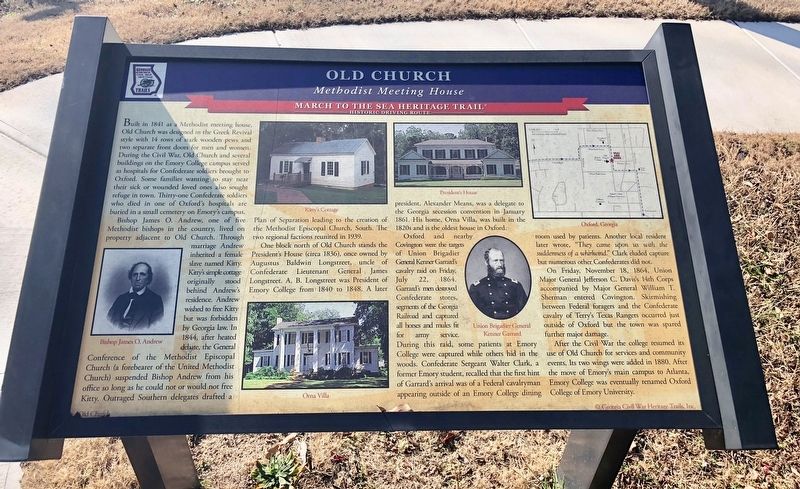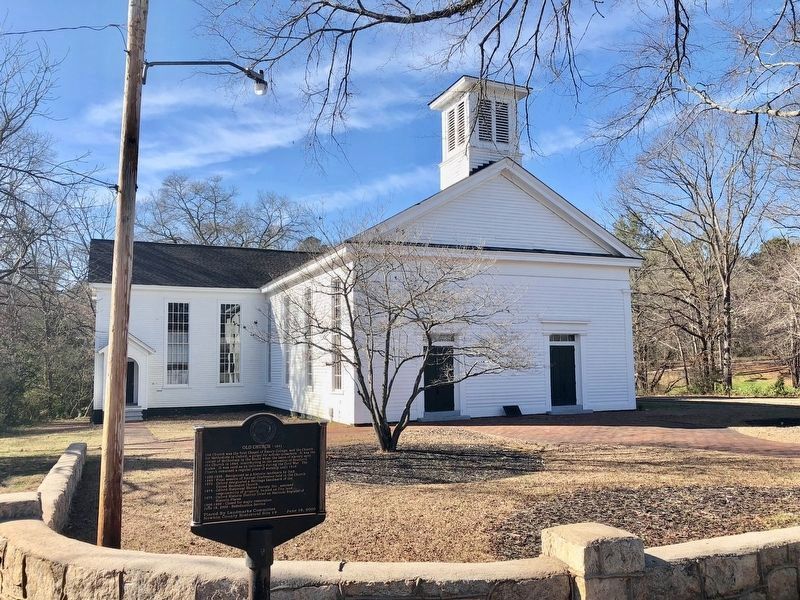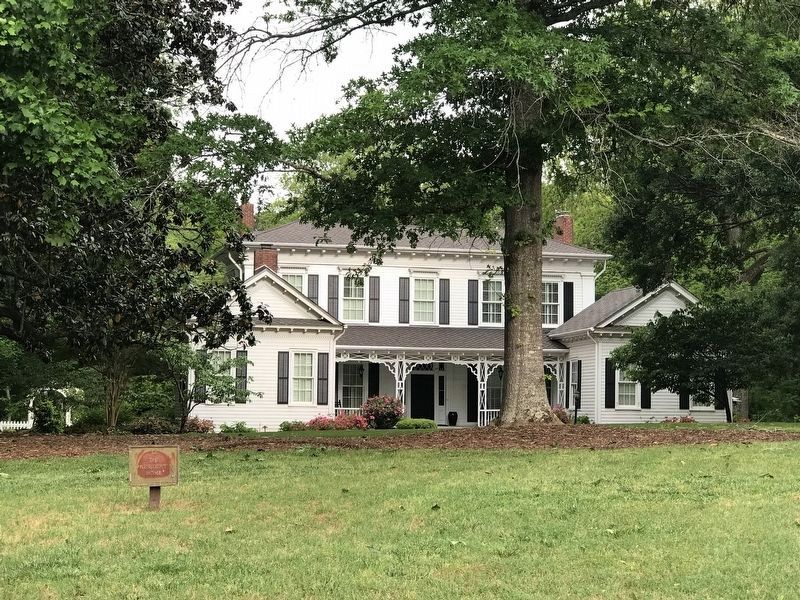Oxford in Newton County, Georgia — The American South (South Atlantic)
Old Church
Methodist Meeting House
— March to the Sea Heritage Trail —
Bishop James O. Andrew, one of five Methodist bishops in the country, lived on property adjacent to Old Church. Through marriage Andrew inherited a female slave named Kitty. Kitty's simple cottage originally stood behind Andrew's residence. Andrew wished to free Kitty but was forbidden by Georgia law. In 1844, after heated debate, the General Conference of the Methodist Episcopal Church (a forebearer of the United Methodist Church) suspended Bishop Andrew from his office so long as he could not or would not free Kitty. Outraged Southern delegates drafted a Plan of Separation leading to the creation of the Methodist Episcopal Church, South. The two regional factions reunited in 1939.
One block north of Old Church stands the President's House (circa 1836), once owned by Augustus Baldwin Longstreet, uncle of Confederate Lieutenant General James Longstreet. A. B. Longstreet was President of Emory College from 1840 to 1848. A later president, Alexander Means, was a delegate to the Georgia secession convention in January 1861. His home, Orna Villa, was built in the 1820s and is the oldest house in Oxford.
Oxford and nearby Covington were the targets of Union Brigadier General Kenner Garrard's cavalry raid on Friday July 22, 1864. Garrard's men destroyed Confederate stores, segments of the Georgia Railroad and captured all horses and mules fit for army service. During this raid, some patients at Emory College were captured while others hid in the woods. Confederate Sergeant Walter Clark, a former Emory student, recalled that the first hint of Garrard's arrival was of a Federal cavalryman appearing outside of an Emory College dining room used by patients. Another local resident later wrote, "They came upon us with the suddenness of a whirlwind." Clark eluded capture but numerous other Confederates did not.
On Friday, November 18, 1864, Union Major General Jefferson C. Davis's 14th Corps accompanied by Major General William T. Sherman entered Covington. Skirmishing between Federal foragers and the Confederate cavalry of Terry's Texas Rangers occurred just outside of Oxford but the town was spared further major damage.
After the
Civil War the college resumed its use of Old Church for services and community events. Its two wings were added in 1880. After the move of Emory's main campus to Atlanta, Emory College was eventually renamed Oxford College of Emory University.
Erected by Georgia Civil War Heritage Trails, Inc. (Marker Number L3.)
Topics and series. This historical marker is listed in these topic lists: African Americans • Churches & Religion • Science & Medicine • War, US Civil. In addition, it is included in the Sherman’s March to the Sea series list. A significant historical month for this entry is January 1861.
Location. 33° 37.511′ N, 83° 52.254′ W. Marker is in Oxford, Georgia, in Newton County. Marker is at the intersection of Wesley Street and Fletcher Street, on the right when traveling north on Wesley Street. Touch for map. Marker is at or near this postal address: 1011 Wesley Street, Oxford GA 30054, United States of America. Touch for directions.
Other nearby markers. At least 8 other markers are within 2 miles of this marker, measured as the crow flies. Old Church - 1841 (within shouting distance of this marker); Kitty's Cottage (within shouting distance of this marker); The Old Oxford Church (within shouting distance of this marker); Town of Oxford, Georgia Historic Shrine of the United Methodist Church (approx. 0.2 miles away); Town of Oxford and Emory College (approx. 0.3 miles away); Garrard’s Cavalry Raid (approx. 1.7 miles away); The Stoneman Raid (approx. 1.7 miles away); The March to the Sea (approx. 1.7 miles away). Touch for a list and map of all markers in Oxford.
Regarding Old Church. Built in 1841 as a Methodist meeting house, Old Church was used as a war-time hospital. The church is adjacent to the slave quarters “Kitty’s Cottage,” with Old Emory College (Oxford College) located nearby. Federal troops were in Oxford multiple times during 1864.
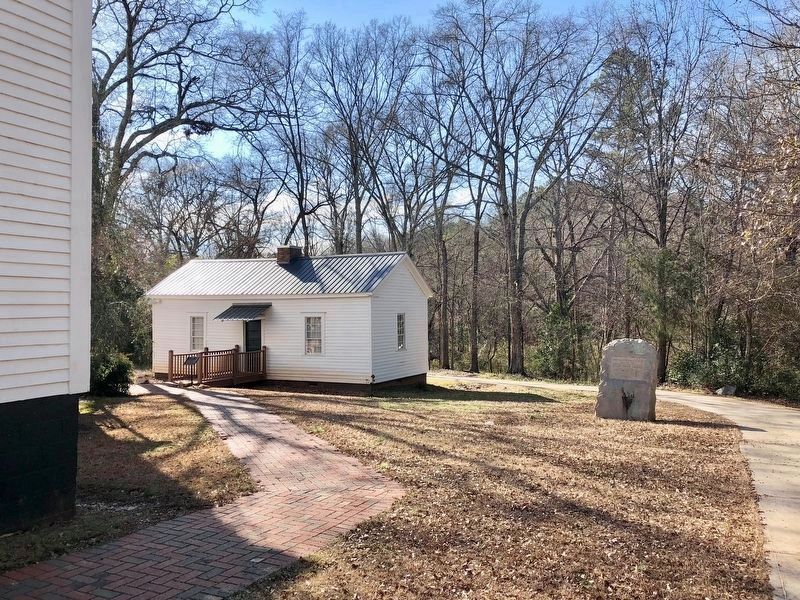
Photographed By Mark Hilton, January 24, 2018
5. Kitty's Cottage, along with a stone marker behind the church.
The cottage was moved four times, finally coming to its current location in the 1990's and placed under the custodianship of the Oxford Historical Shrine Society. It has become the symbol of the great dividing conflict the Methodist Church experienced over the issue of slavery in the 1840's.
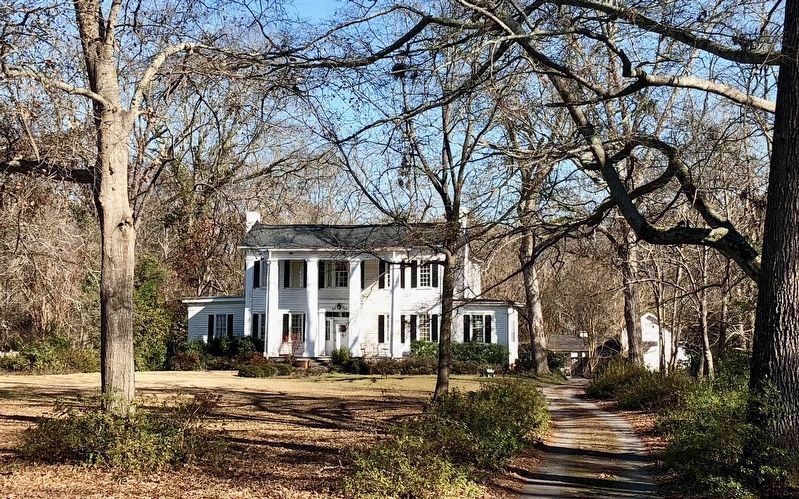
Photographed By Mark Hilton, January 24, 2018
6. Orna Villa (the Alexander Means house) located on Emory Street, near East Clark Street.
Circa 1820. Greek Revival. The oldest home in Oxford (even pre-dating Emory College), Orna Villa was built by Dr. Alexander Means around the foundation of an 18th century farmhouse. Dr. Means, a Renaissance man of many interests, was a medical doctor, professor of natural science, Methodist minister, renowned orator, and inventor. He also served as the fourth president of Emory College. Listed on the National Register of Historic Places, Orna Villa is said to be haunted by the ghost of Dr. Means’s son, Toby.
Credits. This page was last revised on May 13, 2022. It was originally submitted on January 25, 2018, by Mark Hilton of Montgomery, Alabama. This page has been viewed 479 times since then and 57 times this year. Photos: 1, 2. submitted on January 25, 2018, by Mark Hilton of Montgomery, Alabama. 3. submitted on May 12, 2022, by Duane and Tracy Marsteller of Murfreesboro, Tennessee. 4, 5, 6. submitted on January 25, 2018, by Mark Hilton of Montgomery, Alabama.
